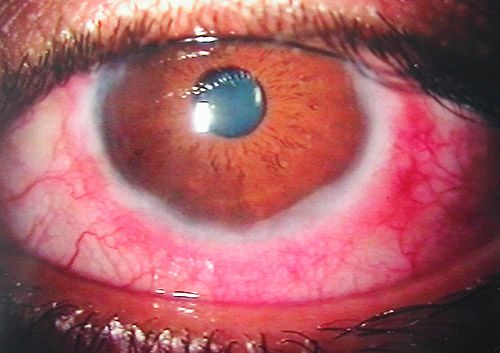Article
Circumnavigating the bumpy road to vernal keratoconjunctivitis: Time is of the essence
Author(s):
Ophthalmologists should look past the eyes in patients presenting with a persistent ocular allergic response and be mindful of accompanying nasal symptoms.
This image shows some of the cornea and conjunctiva findings in vernal conjunctivitis. (File photo)

Reviewed by Leonard Bielory, MD
Vernal keratoconjunctivitis (VKC) is rare and may not be in the forefront of clinicians’ minds when evaluating a child with a persistent allergic ocular surface complaint. In fact, 88% of clinicians in a study reported by Leonard Bielory, MD, noted that primary care physicians and pediatricians commonly underdiagnose or misdiagnose the disorder—which then goes untreated or undertreated—largely because the later involvement of the cornea can be misleading.
This limited awareness is the focus for Bielory, who emphasized it as a barrier to timely identification and management of this disruptive ocular surface disorder. VKC frequently is initially misidentified as an allergy or infection, and referral to a specialist often is delayed until symptoms become severe.
Bielory is a professor of medicine, allergy, immunology, and ophthalmologyat Hackensack Meridian School of Medicine in Nutley, New Jersey; an adjunct professor at the Center of Aerobiological Research at Rutgers University in New Brunswick, New Jersey; and direc at Kean University in Union, New Jersey.
The VKC enigma
VKC—a progressive, vision-threatening condition that begins in the warm months worldwide—can lead clinicians to believe it is just springtime (or “vernal”) allergic conjunctivitis. The corneal inflammatory component, however, emerges later and is recurring. The key factor, Bielory said, is that VKC should be considered in children who present with a persistent ocular allergic complaint that may be the more pronounced type of conjunctivitis that can affect the cornea. “The condition is thought to mislead clinicians into thinking it is just a seasonal problem [but it] may also have a perennial component that develops with time,” he stated.
A clue to diagnosing VKC may emerge when parents report using OTC ocular treatments to no avail. “This should be the trigger to additional, more thoughtful involvement by their clinicians, such as referral to allergy specialists and ophthalmologists,” Bielory advised.
The following timeline may be helpful. Bielory explained that during the patient’s first season with an ocular reaction, vernal conjunctivitis and seasonal conjunctivitis may have similar presentations. During the second season of the allergic response, the vernal component (associated with warmth and different regional pollinating seasons) begins to progress more than the seasonal component, which remains seasonal. Then, possibly during the second and third seasons, a great degree of progression may be seen during the year of sensitization, while keeping in mind that there are individual degrees of progression among patients. The patient then moves into the clinical phase.
Bielory explained that a confounding factor in the diagnosis of VKC is how allergies develop (ie, over time). Immunoglobulin G antibodies inherited from the mothers protect babies for about 6 months. Immunoglobulin E, the allergy antibody, requires exposure to an offending agent over time followed by development of the immune system against that agent.
Allergies may begin to manifest in babies from 6 to 9 months after birth. Allergies exhibit nasal and ocular symptoms (rhinoconjunctivitis) in almost equal proportions, which physicians also should know.
During the second year for children with developing VKC, symptoms worsen and become more unresponsive to treatment. An allergy workup is needed, but when ocular steroids are prescribed and the patient does not improve, clinicians should suspect something more than seasonal allergic conjunctivitis (ie, the vernal component), Bielory said.
VKC appearance
Minor VKC symptoms include photophobia, tearing, burning, and pruritus, with minimal impact on patient quality of life. This scenario often is misdiagnosed as pink eye or allergic conjunctivitis.
Moderate VKC symptoms include photophobia, pruritus, and discharge of mucus with moderate size and number of cobblestone papillae in the upper tarsal conjunctiva or around the edge of the cornea (limbal form of VKC). Patient quality of life is moderately affected.
Severe symptoms of photophobia, pruritus, and discharge of mucus are accompanied by large cobblestone papillae, punctate epithelial erosions, and Horner-Trantas dots. Quality of life is substantially affected and the disease potentially can threaten vision if left untreated as it starts to affect the visual axis of the cornea.
VKC treatment
Within this less-than-clear clinical picture, several treatments can be called into play. As mentioned, OTC ocular treatments will not work. Use of oral antihistamines may cause increased ocular dryness over and above the abnormal tear film development in the vernal component.
“With antihistamines, there begins to be an increase in tear film dysfunction that comes with the allergy affecting the ocular surface,” Bielory said. However, in VKC, overproduction of tears in response to corneal irritation usually leads to practitioners increasing the use of antihistamines, compounding the ocular surface issue,” he added.
Treatment of the ocular surface then progresses from the lubricants to ophthalmic antihistamines to steroids. Bielory uses the steroid burst treatments over 1 to 2 weeks to avoid increases in IOP.
He advised that physicians be aware of chronic immunologic signs of inflammation that induces follicular islands of activity of certain cell types that will lead to corneal involvement. At this point, steroid-sparing treatments should be introduced, such as cyclosporine, which addresses more specific immunological entities that decrease the overall immune response of IL-2 and the cytokines, he explained.
Cyclosporine ophthalmic emulsion 0.1% (Verkazia; Santen), a steroid-sparing drug, is the first and only FDA-approved topical immunomodulator for treating adults and children with VKC. In addition, Sinusol Breathe Easy (DRBRX), a nonsteroidal therapy OTC product , works by clearing nasal mucus and decongestion, which also benefits the ocular symptoms associated with allergies.
Leonard Bielory, MD
Bielory is a consultant to Santen Pharmaceutical and DRBRX.
Newsletter
Don’t miss out—get Ophthalmology Times updates on the latest clinical advancements and expert interviews, straight to your inbox.
2 Commerce Drive
Cranbury, NJ 08512
All rights reserved.





